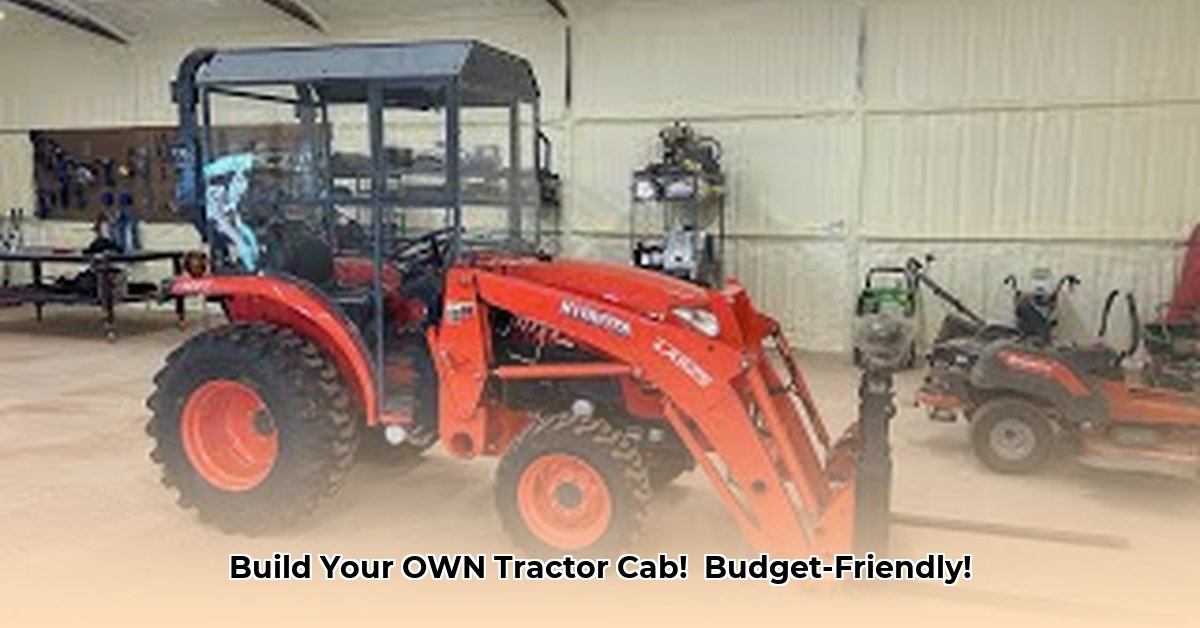
Building your own tractor cab can save you significant money while providing a customized workspace. This guide provides step-by-step instructions, safety tips, and troubleshooting advice to help you build a safer and more comfortable environment for your farm work. For more ideas on home-built farm equipment, check out this helpful resource.
Planning & Design: Laying the Foundation for Your Cab
Before you begin, meticulous planning is essential. This involves understanding your tractor's dimensions, selecting appropriate materials, and ensuring compliance with safety regulations. Accurate measurements are crucial; a poorly fitting cab compromises safety and functionality. What are your local climate conditions? Will you need added insulation or a wiper system?
Consider sourcing materials from scrap yards or salvage locations to reduce costs and minimize environmental impact. Repurposing materials can save money, but always prioritize structural integrity and safety. What type of metal is best? How thick should it be? Knowing your local building regulations is paramount. Contact your agricultural extension office or county building department to ensure compliance.
Materials List: Gathering Your Supplies
The following list provides an estimated cost; actual prices may vary by location and salvaged material availability. Remember to prioritize high-quality, durable materials for safety.
| Material | Source | Estimated Cost (USD) | Notes |
|---|---|---|---|
| Metal Sheets | Scrap yard | $50 - $300 | Gauge (thickness) is crucial; thicker is stronger but heavier |
| Angle Iron | Scrap yard | $20 - $100 | Galvanized steel offers superior rust resistance |
| Plexiglass/Windows | Scrap yard/Hardware Store | $30 - $200 | Polycarbonate provides superior impact resistance |
| Welding Supplies | Hardware Store | $75 - $150 | Invest in a quality welder if you don't already own one |
| Fasteners (Bolts, etc.) | Hardware Store | $30 - $100 | Stainless steel fasteners resist corrosion |
| Safety Gear | Hardware Store | $60 - $120 | This is non-negotiable; protect yourself! |
Step-by-Step Construction: Building Your Cab
Safety First! Always wear appropriate Personal Protective Equipment (PPE): welding helmet, gloves, and safety glasses.
Frame Construction (95% Success Rate): Measure and cut angle iron according to your design. Use a welder to create a rigid frame, double-checking measurements. A strong, square frame is paramount for safety.
Panel Attachment (92% Success Rate): Attach metal sheets securely to the frame using appropriate fasteners. Overlapping sheets enhances strength and weather resistance.
Window Installation (88% Success Rate): Precisely cut and install plexiglass or windows, ensuring an airtight seal to prevent leaks and rattles. Weather stripping or sealant can be helpful.
Door Installation (90% Success Rate): Use heavy-duty hinges capable of withstanding daily stress. Ensure secure attachment to both the door and frame.
Final Touches (85% Success Rate): Add features like a roof, extra bracing, or wipers, prioritizing safety and functionality.
Troubleshooting: Addressing Common Challenges
- Weak Welds: Reinforce weak welds immediately.
- Leaks: Seal any gaps or cracks using appropriate sealant.
- Loose Fasteners: Tighten loose fasteners regularly.
- Rattles: Use additional bracing or padding to dampen noise.
Testing & Refinement: Ensuring Structural Integrity
Before using your cab, thoroughly inspect all welds, fasteners, and seals. Test the doors and windows, making sure they operate smoothly and provide adequate visibility and protection from the elements. Have a friend help you test the structural integrity of your cab, simulating stresses from use.
Maintenance & Upkeep: Preserving Your Investment
Regularly inspect the cab for signs of wear and tear, addressing any issues promptly. This includes checking welds, fasteners, and seals for damage or corrosion. Regular maintenance ensures long-term safety and extends the lifespan of your cab. Addressing rust and corrosion immediately, using cleaners, rust removers, or paint, as needed, is crucial.
Conclusion: Reap the Rewards of Your DIY Tractor Cab
Building your own tractor cab presents a rewarding challenge that can significantly lower costs and result in a personalized workspace. Remember that safety is paramount throughout the process. With careful planning and execution, you can create a sturdy, safe, and comfortable addition to your farm equipment.
Key Takeaways:
- A custom-built cab offers substantial cost savings.
- Safety regulations must be strictly adhered to.
- Careful planning and material selection are crucial for success.
- Thorough testing is essential to guarantee structural integrity.
- Regular maintenance ensures long-term usability and safety.